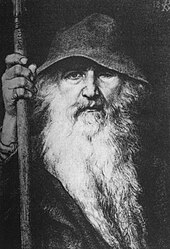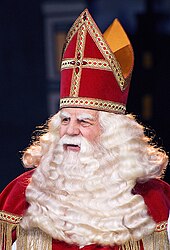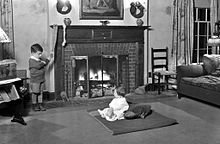Santa 1881. Illustration by Thomas Nast who, wi
Post# of 63902
Santa 1881.
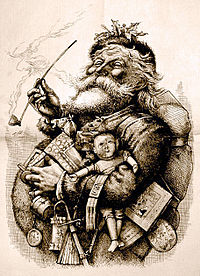
Illustration by Thomas Nast who, with Clement Clarke Moore , helped to create the modern image of Santa Claus.
Wikipedia.
http://en.wikipedia.org/wiki/Santa_Claus
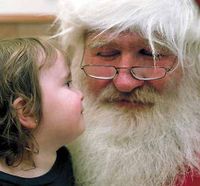
The modern portrayal of Santa Claus frequently depicts him listening to the Christmas wishes of young children.
Santa Claus , also known as Saint Nicholas , Father Christmas and simply " Santa ", is a figure with legendary , mythical, historical and folkloric origins who, in many western cultures , is said to bring gifts to the homes of the good children during the late evening and overnight hours of Christmas Eve , December 24. During the Christianization of Germanic Europe , this figure may have absorbed elements of the god Odin , who was associated with the pre-Christian midwinter event of Yule and led the Wild Hunt , a ghostly procession through the sky. The modern figure of Santa Claus was derived from the Dutch figure of Sinterklaas , which, in turn, was part of its basis in hagiographical tales concerning the historical figure of Christian bishop and gift giver Saint Nicholas .
Santa Claus is generally depicted as a portly, joyous, white-bearded man—sometimes with spectacles —wearing a red coat with white collar and cuffs, white-cuffed red trousers, and black leather belt and boots (images of him rarely have a beard with no moustache). This image became popular in the United States and Canada in the 19th century due to the significant influence of Clement Clarke Moore 's 1823 poem " A Visit From St. Nicholas " and of caricaturist and political cartoonist Thomas Nast . [ 1 ] [ 2 ] [ 3 ] This image has been maintained and reinforced through song, radio, television, children's books and films .
According to a tradition which can be traced to the 1820s, Santa Claus lives at the North Pole , with a large number of magical elves , and nine (originally eight) flying reindeer . Since the 20th century, in an idea popularized by the 1934 song " Santa Claus Is Coming to Town ", Santa Claus has been believed to make a list of children throughout the world, categorizing them according to their behavior ("naughty" or "nice") and to deliver presents, including toys , and candy to all of the well-behaved children in the world, and sometimes coal to the naughty children, on the single night of Christmas Eve. He accomplishes this feat with the aid of the elves who make the toys in the workshop and the reindeer who pull his sleigh. [ 4 ] [ 5 ]
Predecessor figures
Saint Nicholas
Saint Nicholas of Myra is the primary inspiration for the Christian figure of Sinterklaas. He was a 4th century Greek Christian bishop of Myra (now Demre) in Lycia , a province of the Byzantine Anatolia , now in Turkey . Nicholas was famous for his generous gifts to the poor, in particular presenting the three impoverished daughters of a pious Christian with dowries so that they would not have to become prostitutes . [ 6 ] He was very religious from an early age and devoted his life entirely to Christianity. In continental Europe (more precisely the Netherlands , Belgium , Austria and Germany ) he is usually portrayed as a bearded bishop in canonical robes. In 1087, the Italian city of Bari , wanting to enter the profitable pilgrimage industry of the times, mounted an expedition to locate the tomb of the Christian Saint and procure his remains. The reliquary of St. Nicholas was conquered by Italian sailors and the spoils, including his relics , taken to Bari [ 7 ] [ 8 ] where they are kept to this day. A basilica was constructed the same year to store the loot and the area became a pilgrimage site for the devout, thus justifying the economic cost of the expedition. Saint Nicholas was later claimed as a patron saint of many diverse groups, from archers , sailors, and children to pawnbrokers . [ 6 ] [ 9 ] He is also the patron saint of both Amsterdam and Moscow . [ 10 ]
Germanic paganism, Odin, and Christianization
Prior to Christianization, the Germanic peoples (including the English; Old English geola or guili ) celebrated a midwinter event called Yule . [ 11 ] With the Christianization of Germanic Europe, numerous traditions were absorbed from Yuletide celebrations into modern Christmas. [ 12 ] During this period, supernatural and ghostly occurrences were said to increase in frequency, such as the Wild Hunt , a ghostly procession through the sky. The leader of the wild hunt is frequently attested as the god Odin and he bears the Old Norse names Jólnir , meaning "yule figure" and the name Langbarðr , meaning "long-beard" (see list of names of Odin ). [ 13 ]
The god Odin's role during the Yuletide period has been theorized as having influenced concepts of St. Nicholas in a variety of facets, including his long white beard and his gray horse for nightly rides (see Odin's horse Sleipnir ), which was traded for reindeer in North America. [ 14 ] Margaret Baker comments that "The appearance of Santa Claus or Father Christmas, whose day is 25th of December, owes much to Odin, the old blue-hooded, cloaked, white-bearded Giftbringer of the north, who rode the midwinter sky on his eight-footed steed Sleipnir , visiting his people with gifts. […] Odin, transformed into Father Christmas, then Santa Claus, prospered with St Nicholas and the Christchild became a leading player on the Christmas stage." [ 15 ]
Dutch folklore
In the Netherlands , Belgium and Luxembourg , Saint Nicholas ("Sinterklaas", often called "De Goede Sint"—"The Good Saint") is an elderly, stately and serious man with white hair and a long, full beard. He wears a long red cape or chasuble over a traditional white bishop's alb and sometimes red stola, dons a red mitre, and holds a gold-coloured crosier, a long ceremonial shepherd's staff with a fancy curled top. To administer the distribution of presents Sinterklaas writes in the book of Saint Nicholas that contains notes on all children that indicate whether the child has been good or naughty during the year. He traditionally rides a white gray. Saint Nicholas is aided by helpers commonly known as Zwarte Piet in Dutch ("Black Peter") or " Père Fouettard " in French. His feast on December 6 came to be celebrated in many countries with the giving of gifts. However, in the Netherlands the Dutch celebrate on the evening of December 5, with a celebration called "pakjesavond". In the Reformation in 16th-17th century Europe, many Protestants and others changed the gift bringer to the Christ Child or Christkindl , and the date for giving gifts changed from December 6 to Christmas Eve. [ 16 ]
Tradition holds that Saint Nicholas (Sinterklaas) and his aides arrive each year by steam boat from Spain in mid November. Black Peter carries with him the book of Saint Nicholas. The rest of the entourage carries gifts, chocolate letters and spice nuts to be handed to the well-behaved children. During the subsequent three weeks, Saint Nicholas is believed to ride a white-grey horse over the rooftops at night, delivering gifts through the chimney to the well-behaved children, while the naughty children risk being caught by Saint Nicholas's aides that carry jute bags and willow canes for that purpose. [ 17 ]
In Netherlands and Belgium next to Sinterklaas the character of Santa Claus is also known, He is known as de Kerstman in Dutch ("the Christmas man") and Père Noël ("Father Christmas") in French. But for children in the Netherlands Sinterklaas is the predominant gift-giver in in December (36% of the population only give presents on Sinterklaas day), Christmas is used by another fifth of the Dutch population to give presents. (21% give presents on Christmas only). Some 26% of the Dutch population give presents on both days. [ 18 ] In Belgium, presents are given to children only, but to almost all of them, on Sinterklaas day. On Christmas Day, everybody receives presents, but often without Santa Claus's help.
In the 1840s, a being in Nordic folklore called " Tomte " or "Nisse" started to deliver the Christmas presents in Denmark . The Tomte was portrayed as a short, bearded man dressed in gray clothes and a red hat. This new version of the age-old folkloric creature was obviously inspired by the Santa Claus traditions that were now spreading to Scandinavia. By the end of the 19th century this tradition had also spread to Norway and Sweden , replacing the Yule Goat. The same thing happened in Finland , but there the more human figure retained the Yule Goat name. But even though the tradition of the Yule Goat as a bringer of presents is now all but extinct, a straw goat is still a common Christmas decoration in all of Scandinavia. Iceland has 13 Yule lads that originate from folklore rather than Christianity and start arriving from the mountains into towns 13 days before December 24.
Father Christmas
Father Christmas dates back as far as 16th century in Britain during the reign of Henry VIII , where he was pictured as a large man in green or scarlet robes lined with fur. [ 19 ] He typified the spirit of good cheer at Christmas, bringing peace, joy, good food and wine and revelry. [ 19 ] As England no longer kept Saint Nicholas feast day on December 6th, the Father Christmas celebration was moved to December 25 to coincide with Christmas Day. [ 19 ] The Victorian revival of Christmas included Father Christmas as the emblem of 'good cheer'. [ 20 ] His physical appearance was variable, with one famous image being John Leech 's illustration of the "Ghost of Christmas Present" in Charles Dickens 's festive classic A Christmas Carol (1843), as a great genial man in a green coat lined with fur who takes Scrooge through the bustling streets of London on the current Christmas morning, sprinkling the essence of Christmas onto the happy populace. [ 19 ] [ 20 ]
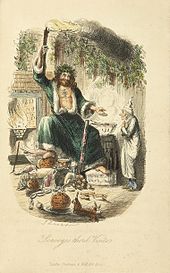
"Ghost of Christmas Present", a colorized version of the original illustration by John Leech made for Charles Dickens 's festive classic A Christmas Carol (1843)
Father Christmas also appears in J. R. R. Tolkien 's The Father Christmas Letters , and briefly in C. S. Lewis 's Chronicles of Narnia novel The Lion, the Witch and the Wardrobe . His presence in Narnia is representative of the White Witch's ailing powers as it often reiterated throughout the novel that she has made it "always winter in Narnia but never Christmas". He makes gifts of armament and tools to the Pevensies in preparation for their intended coup of the White Witch. [ 21 ]
History
Origins
Pre-modern representations of the gift-giver from church history and folklore, notably St Nicholas and Sinterklaas , merged with the British character Father Christmas to create the character known to Britons and Americans as Santa Claus .
In the British colonies of North America and later the United States , British and Dutch versions of the gift-giver merged further. For example, in Washington Irving 's History of New York (1809), Sinterklaas was Americanized into "Santa Claus" (a name first used in the American press in 1773) [ 22 ] but lost his bishop’s apparel, and was at first pictured as a thick-bellied Dutch sailor with a pipe in a green winter coat. Irving’s book was a lampoon of the Dutch culture of New York , and much of this portrait is his joking invention.
19th century
"December 24, 1864. This has usually been a very busy day with me, preparing for Christmas not only for my own tables, but for gifts for my servants. Now how changed! No confectionary, cakes, or pies can I have. We are all sad; no loud, jovial laugh from our boys is heard. Christmas Eve, which has ever been gaily celebrated here, which has witnessed the popping of firecrackers … and the hanging up of stockings, is an occasion now of sadness and gloom. I have nothing even to put in 8-year-old daughter Sadai's stocking, which hangs so invitingly for Santa Claus . How disappointed she will be in the morning, though I have explained to her why he cannot come. Poor children! Why must the innocent suffer with the guilty?"
In 1821, the book A New-year's present, to the little ones from five to twelve was published in New York. It contained Old Santeclaus , an anonymous poem describing an old man on a reindeer sleigh, bringing presents to children. [ 24 ] Some modern ideas of Santa Claus seemingly became canon after the anonymous publication of the poem " A Visit From St. Nicholas " (better known today as "The Night Before Christmas") in the Troy, New York , Sentinel on December 23, 1823; the poem was later attributed to Clement Clarke Moore . [ 6 ] Many of his modern attributes are established in this poem, such as riding in a sleigh that lands on the roof, entering through the chimney, and having a bag full of toys. St. Nick is described as being "chubby and plump, a right jolly old elf" with "a little round belly", that "shook when he laughed like a bowlful of jelly", in spite of which the "miniature sleigh" and "tiny reindeer" still indicate that he is physically diminutive. The reindeer were also named: Dasher, Dancer, Prancer, Vixen, Comet, Cupid, Dunder and Blixem (Dunder and Blixem came from the old Dutch words for thunder and lightning, which were later changed to the more German sounding Donner and Blitzen). [ 25 ]
As the years passed, Santa Claus evolved in popular culture into a large, heavyset person. One of the first artists to define Santa Claus's modern image was Thomas Nast , an American cartoonist of the 19th century. In 1863, a picture of Santa illustrated by Nast appeared in Harper's Weekly .

Thomas Nast immortalized Santa Claus with an illustration for the January 3, 1863 issue of Harper's Weekly . Note that Santa is dressed in an American flag , and has a puppet with the name " Jeff " written on it, reflecting its Civil War context.
The story that Santa Claus lives at the North Pole may also have been a Nast creation. His Christmas image in the Harper’s issue dated December 29, 1866 was a collage of engravings titled Santa Claus and His Works , which included the caption "Santa Claussville, N.P." [ 26 ] A color collection of Nast's pictures, published in 1869, had a poem also titled "Santa Claus and His Works" by George P. Webster, who wrote that Santa Claus’s home was "near the North Pole, in the ice and snow". [ 27 ] The tale had become well known by the 1870s. A boy from Colorado writing to the children's magazine The Nursery in late 1874 said, "If we did not live so very far from the North Pole, I should ask Santa Claus to bring me a donkey." [ 28 ]
The idea of a wife for Santa Claus may have been the creation of American authors, beginning in the mid-1800s. In 1889, the poet Katherine Lee Bates popularized Mrs. Claus in the poem "Goody Santa Claus on a Sleigh Ride".
"Is There a Santa Claus?" was the title of an editorial appearing in the September 21, 1897 edition of the New York Sun . The editorial, which included the famous reply Yes, Virginia, there is a Santa Claus , has become an indelible part of popular Christmas lore in the United States and Canada.
20th century
L. Frank Baum 's The Life and Adventures of Santa Claus , a 1902 children's book , further popularized Santa Claus. Much of Santa Claus’s mythos was not set in stone at the time, leaving Baum to give his "Neclaus" (Necile’s Little One) a wide variety of immortal support, a home in the Laughing Valley of Hohaho, and ten reindeer—who could not fly, but leapt in enormous, flight-like bounds. Claus's immortality was earned, much like his title ("Santa"), decided by a vote of those naturally immortal. This work also established Claus’s motives: a happy childhood among immortals. When Ak, Master Woodsman of the World, exposes him to the misery and poverty of children in the outside world, Santa strives to find a way to bring joy into the lives of all children, and eventually invents toys as a principal means.
Images of Santa Claus were further popularized through Haddon Sundblom ’s depiction of him for The Coca-Cola Company ’s Christmas advertising in the 1930s. [ 6 ] [ 29 ] The popularity of the image spawned urban legends that Santa Claus was invented by The Coca-Cola Company or that Santa wears red and white because they are the colors used to promote the Coca-Cola brand. [ 30 ] Historically, Coca-Cola was not the first soft drink company to utilize the modern image of Santa Claus in its advertising— White Rock Beverages had already used a red and white Santa to sell mineral water in 1915 and then in advertisements for its ginger ale in 1923. [ 31 ] [ 32 ] [ 33 ] Earlier still, Santa Claus had appeared dressed in red and white and essentially in his current form on several covers of Puck magazine in the first few years of the twentieth century. [ 34 ]

A man dressed up as Santa Claus fundraising for Volunteers of America on the sidewalk of street in Chicago, Illinois , in 1902. He is wearing a mask with a beard attached.
The image of Santa Claus as a benevolent character became reinforced with its association with charity and philanthropy , particularly by organizations such as the Salvation Army . Volunteers dressed as Santa Claus typically became part of fundraising drives to aid needy families at Christmas time.
In 1937, Charles W. Howard , who played Santa Claus in department stores and parades, established the Charles W. Howard Santa School, the oldest continuously-run such school in the world. [ 35 ]
In some images from the early 20th century, Santa was depicted as personally making his toys by hand in a small workshop like a craftsman. Eventually, the idea emerged that he had numerous elves responsible for making the toys, but the toys were still handmade by each individual elf working in the traditional manner.
The 1956 popular song by George Melachrino , "Mrs. Santa Claus", and the 1963 children's book How Mrs. Santa Claus Saved Christmas , by Phyllis McGinley , helped standardize and establish the character and role of Mrs. Claus in the popular imagination.
Seabury Quinn ’s 1948 novel Roads draws from historical legends to tell the story of Santa and the origins of Christmas. Other modern additions to the "story" of Santa include Rudolph the Red-Nosed Reindeer , the 9th and lead reindeer immortalized in a Gene Autry song, written by a Montgomery Ward copywriter.
In popular culture
By the end of the 20th century, the reality of mass mechanized production became more fully accepted by the Western public. [ citation needed ] That shift was reflected in the modern depiction of Santa's residence—now often humorously portrayed as a fully mechanized production and distribution facility, equipped with the latest manufacturing technology, and overseen by the elves with Santa and Mrs. Claus as executives and/or managers. [ 36 ] An excerpt from a 2004 article, from a supply chain managers' trade magazine, aptly illustrates this depiction:
Santa's main distribution center is a sight to behold. At 4,000,000 square feet (370,000 m 2 ), it's one of the world's largest facilities. A real-time warehouse management system (WMS) is of course required to run such a complex. The facility makes extensive use of task interleaving, literally combining dozens of DC activities (putaway, replenishing, order picking, sleigh loading, cycle counting) in a dynamic queue...the DC elves have been on engineered standards and incentives for three years, leading to a 12% gain in productivity ...The WMS and transportation system are fully integrated, allowing (the elves) to make optimal decisions that balance transportation and order picking and other DC costs. Unbeknownst to many, Santa actually has to use many sleighs and fake Santa drivers to get the job done Christmas Eve, and the transportation management system (TMS) optimally builds thousands of consolidated sacks that maximize cube utilization and minimize total air miles. [ 37 ]
Santa has been described as a positive male cultural icon :
Santa is really the only cultural icon we have who's male, doesn't carry a gun, and is all about peace, joy, giving, and caring for other people. That's part of the magic for me, especially in a culture where we've become so commercialized and hooked into manufactured icons. Santa is much more organic, integral, connected to the past, and therefore connected to the future.
—TV producer Jonathan Meath who portrays Santa, 2011 [ 38 ]
Many television commercials , comic strips and other media depict this as a sort of humorous business, with Santa's elves acting as a sometimes mischievously disgruntled workforce, cracking jokes and pulling pranks on their boss. For instance, a Bloom County story from December 15, 1981 through December 24, 1981 has Santa rejecting the demands of PETCO (Professional Elves Toy-Making and Craft Organization) for higher wages, a hot tub in the locker room, and “short broads,” with the elves then going on strike. President Reagan steps in, fires all of Santa’s helpers, and replaces them with out-of-work air traffic controllers (an obvious reference to the 1981 air traffic controllers' strike ), resulting in a riot before Santa vindictively rehires them in humiliating new positions such as his reindeer. [ 39 ] In The Sopranos episode, " ...To Save Us All from Satan's Power ", Paulie Gualtieri says he "Used to think Santa and Mrs. Claus were running a sweatshop over there. ... The original elves were ugly, traveled with Santa to throw bad kids a beatin', and gave the good ones toys."
In Kyrgyzstan , a mountain peak was named after Santa Claus, after a Swedish company had suggested the location be a more efficient starting place for present-delivering journeys all over the world, than Lapland. In the Kyrgyz capital, Bishkek , a Santa Claus Festival was held on December 30, 2007, with government officials attending. 2008 was officially declared the Year of Santa Claus in the country. The events are seen as moves to boost tourism in Kyrgyzstan. [ 40 ]
The Guinness World Record for the largest gathering of Santa Clauses is held by Derry City, Northern Ireland. On September 9, 2007. A total of 12,965 people dressed up as Santa or Santa's helper brought down the previous record of 3,921, which was set during the Santa Dash event in Liverpool City Centre in 2005. [ 41 ] A gathering of Santas in 2009 in Bucharest, Romania attempted top the world record, but failed with only 3939 Santas. [ 42 ]
Traditions and rituals
Chimney tradition
The tradition of Santa Claus entering dwellings through the chimney is shared by many European seasonal gift-givers. In pre-Christian Norse tradition, Odin would often enter through chimneys and fireholes on the solstice. [ citation needed ] In the Italian Befana tradition, the gift-giving witch is perpetually covered with soot from her trips down the chimneys of children's homes. In the tale of Saint Nicholas, the saint tossed coins through a window, and, in a later version of the tale, down a chimney when he finds the window locked. In Dutch artist
 (0)
(0) (0)
(0)
